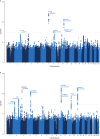Environmental and genetic predictors of human cardiovascular ageing
- PMID: 37604819
- PMCID: PMC10442405
- DOI: 10.1038/s41467-023-40566-6
Environmental and genetic predictors of human cardiovascular ageing
Abstract
Cardiovascular ageing is a process that begins early in life and leads to a progressive change in structure and decline in function due to accumulated damage across diverse cell types, tissues and organs contributing to multi-morbidity. Damaging biophysical, metabolic and immunological factors exceed endogenous repair mechanisms resulting in a pro-fibrotic state, cellular senescence and end-organ damage, however the genetic architecture of cardiovascular ageing is not known. Here we use machine learning approaches to quantify cardiovascular age from image-derived traits of vascular function, cardiac motion and myocardial fibrosis, as well as conduction traits from electrocardiograms, in 39,559 participants of UK Biobank. Cardiovascular ageing is found to be significantly associated with common or rare variants in genes regulating sarcomere homeostasis, myocardial immunomodulation, and tissue responses to biophysical stress. Ageing is accelerated by cardiometabolic risk factors and we also identify prescribed medications that are potential modifiers of ageing. Through large-scale modelling of ageing across multiple traits our results reveal insights into the mechanisms driving premature cardiovascular ageing and reveal potential molecular targets to attenuate age-related processes.
© 2023. Springer Nature Limited.
Conflict of interest statement
J.M., E.E., I.K., C.B. and D.F.F. are full-time employees of Bayer AG, Germany. D.P.O’R. has received research support and consultancy fees from Bayer AG. The remaining authors declare no competing interests.
Figures








References
-
- United Nations. World population prospects 2019. Vol (ST/ESA/SE. A/424) Department of Economic and Social Affairs: Population Division (2019).
Publication types
MeSH terms
Grants and funding
LinkOut - more resources
Full Text Sources
Medical

